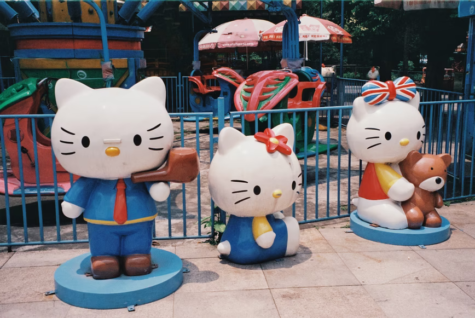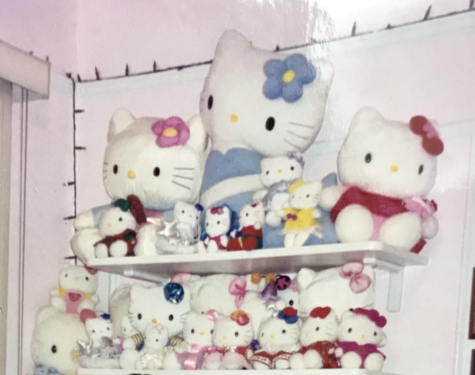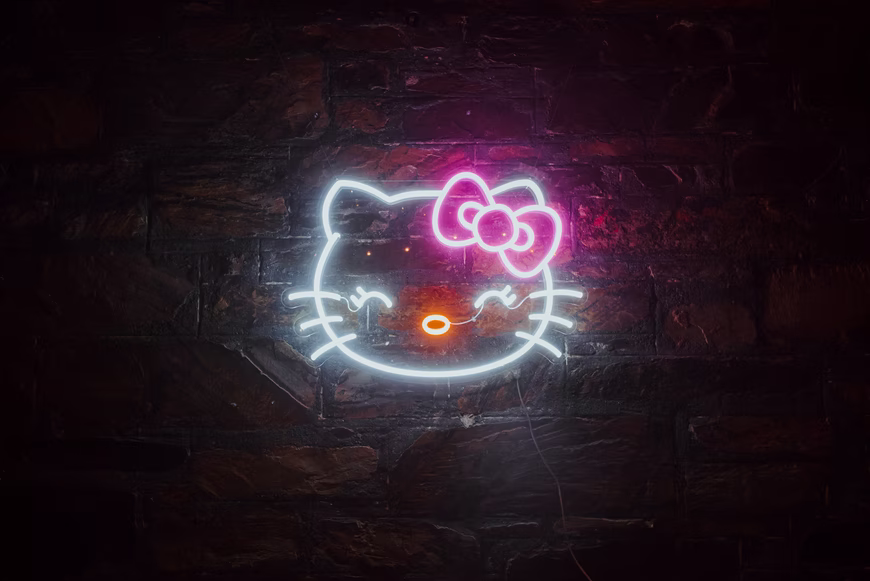How Hello Kitty Took Over the World
The character on a coin purse kickstarted global success for a Japanese company, remaining a symbol of cute and retro culture today.
Hello Kitty has long been an icon of the “kawaii” part of Japanese culture.
At just “five apples tall” with a trademark pink bow adorning her forehead, it comes as a surprise to many that the popular character Hello Kitty is in reality a human girl named Kitty White. Hello Kitty’s name has been heard around the world for decades, widely known as the beloved cartoon character created by the Japanese company Sanrio. Since its founding in 1960, the company has created hundreds of characters, with Hello Kitty being the figurehead of this colorful roster.
The girl who is most commonly known as Hello Kitty resides in the suburbs of London, with her parents and twin sister Mimmy, according to the profiles on the official Japanese and English Sanrio websites. She is formally classified as a “gijinka,” meaning that she is the personification of a cat, but isn’t exactly one either. She has the weight of three apples and loves making friends, but one of Hello Kitty’s most significant features is her lack of a mouth.
At first glance, this may be her most perplexing feature, but it has significant meaning beyond the confusion. A big part of Sanrio’s brand is a commitment to social communication, defined by founder Shintaro Tsuji as “the expression of respect and love.”
In regards to this, Sanrio puts an emphasis on the heart, as Mr. Tsuji explains. “The common thread running through all our various business is the idea of giving ‘from the heart’ and ‘of the heart,’” Tsuji said. Hello Kitty’s mouthless expression encapsulates the idea of speaking from the heart rather than the mouth.
Hello Kitty was officially created by Yuko Shimizu in 1974 and made her first appearance on a vinyl coin purse the next year, which marked the beginning of her rise to global fame.

Sanrio received incredible initial success in sales thanks to the creation and proliferation of the first Hello Kitty products around the world. Additional contributions came from the creation of subsequent characters such as My Melody as well as the establishment of Sanrio, Inc. in California just a year after the first Hello Kitty product was released, according to the company history timeline.
When asked about their favorite Sanrio characters, various Bronx Science students responded with the company’s most successful characters, the most commonly mentioned one being Hello Kitty. However, Mysha Rahman ’23 said that the Little Twin Stars took top place as “they’re the cutest, and they’re also underrated.”
The interesting spread of student responses has a lot to do with how the Sanrio characters are represented in social media culture today. Maliha Chowdhury ’24 said, “I heard of it through some aesthetic posts that some people post online, but I don’t really know a whole lot about Sanrio.”
The history of how Hello Kitty became so well-known, along with Sanrio’s rise in popularity, can be connected to the larger spread of the “sanriocore” or “soft” aesthetic, influenced by the “kawaii” part of Japanese popular culture. “Kawaii” means ‘cute’ in Japanese.

These aesthetics — involving pastel colors and cute characters — have influenced a youthful wave of fashion, makeup, and overall presentation. They have spread over social media platforms, such as TikTok and Instagram, where people post photos and videos of clothes, accessories, and decorations, which often feature the adorable Sanrio characters.
However, only certain Sanrio characters have been incorporated into the popular aesthetic, and other characters such as the Little Twin Stars and Tuxedo Sam have simply not had the chance to shine in the spotlight.
Meanwhile, characters such as My Melody and Kuromi gained extreme popularity, especially within the past two years. This is due to their complementing black and pink color palettes that serve as inspiration for matching items ranging from outfits to matching profile pictures online.
An interesting observation within our community points to the possibility that the company’s characters may have outshined the company’s name itself.
When asked about any previous knowledge about the company, not many people actually recognized the name Sanrio. “Although I was not aware of the name of the company, I was familiar with the character Hello Kitty,” said Khado Tsephel ’23.
The characters created by Sanrio all have their own unique charm, but the company’s overall success can be attributed to Hello Kitty’s iconic design and message of friendship and finding joy in a “small gift, big smile.”
Mr. Tsuji explains, “The common thread running through all our various business is the idea of giving ‘from the heart’ and ‘of the heart.’” Hello Kitty’s mouthless expression encapsulates the idea of speaking from the heart rather than the mouth.
Elizabeth Colón is a Copy Chief for ‘The Science Survey.’ Elizabeth finds that the most appealing aspect of journalistic writing is how much...











